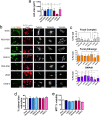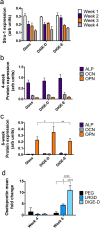Cell-controlled dynamic surfaces for skeletal stem cell growth and differentiation
- PMID: 35581256
- PMCID: PMC9114122
- DOI: 10.1038/s41598-022-12057-z
Cell-controlled dynamic surfaces for skeletal stem cell growth and differentiation
Abstract
Skeletal stem cells (SSCs, or mesenchymal stromal cells typically referred to as mesenchymal stem cells from the bone marrow) are a dynamic progenitor population that can enter quiescence, self-renew or differentiate depending on regenerative demand and cues from their niche environment. However, ex vivo, in culture, they are grown typically on hard polystyrene surfaces, and this leads to rapid loss of the SSC phenotype. While materials are being developed that can control SSC growth and differentiation, very few examples of dynamic interfaces that reflect the plastic nature of the stem cells have, to date, been developed. Achieving such interfaces is challenging because of competing needs: growing SSCs require lower cell adhesion and intracellular tension while differentiation to, for example, bone-forming osteoblasts requires increased adhesion and intracellular tension. We previously reported a dynamic interface where the cell adhesion tripeptide arginine-glycine-aspartic acid (RGD) was presented to the cells upon activation by user-added elastase that cleaved a bulky blocking group hiding RGD from the cells. This allowed for a growth phase while the blocking group was in place and the cells could only form smaller adhesions, followed by an osteoblast differentiation phase that was induced after elastase was added which triggered exposure of RGD and subsequent cell adhesion and contraction. Here, we aimed to develop an autonomous system where the surface is activated according to the need of the cell by using matrix metalloprotease (MMP) cleavable peptide sequences to remove the blocking group with the hypothesis that the SSCs would produce higher levels of MMP as the cells reached confluence. The current studies demonstrate that SSCs produce active MMP-2 that can cleave functional groups on a surface. We also demonstrate that SSCs can grow on the uncleaved surface and, with time, produce osteogenic marker proteins on the MMP-responsive surface. These studies demonstrate the concept for cell-controlled surfaces that can modulate adhesion and phenotype with significant implications for stem cell phenotype modulation.
© 2022. The Author(s).
Conflict of interest statement
The authors declare no competing interests.
Figures





Similar articles
-
RGD and BMP-2 mimetic peptide crosstalk enhances osteogenic commitment of human bone marrow stem cells.Acta Biomater. 2016 May;36:132-42. doi: 10.1016/j.actbio.2016.03.032. Epub 2016 Mar 18. Acta Biomater. 2016. PMID: 27000551
-
Time-responsive osteogenic niche of stem cells: A sequentially triggered, dual-peptide loaded, alginate hybrid system for promoting cell activity and osteo-differentiation.Biomaterials. 2018 May;163:25-42. doi: 10.1016/j.biomaterials.2018.02.025. Epub 2018 Feb 10. Biomaterials. 2018. PMID: 29452946
-
RGD-grafted thermoreversible polymers to facilitate attachment of BMP-2 responsive C2C12 cells.Biomaterials. 2005 Dec;26(35):7329-38. doi: 10.1016/j.biomaterials.2005.05.060. Biomaterials. 2005. PMID: 16019067
-
Skeletal stem and progenitor cells in bone development and repair.J Bone Miner Res. 2024 Jul 23;39(6):633-654. doi: 10.1093/jbmr/zjae069. J Bone Miner Res. 2024. PMID: 38696703 Review.
-
Bone Marrow Niches for Skeletal Progenitor Cells and their Inhabitants in Health and Disease.Curr Stem Cell Res Ther. 2019;14(4):305-319. doi: 10.2174/1574888X14666190123161447. Curr Stem Cell Res Ther. 2019. PMID: 30674266 Review.
Cited by
-
Induced Pluripotent (iPSC) and Mesenchymal (MSC) Stem Cells for In Vitro Disease Modeling and Regenerative Medicine.Int J Mol Sci. 2025 Jun 11;26(12):5617. doi: 10.3390/ijms26125617. Int J Mol Sci. 2025. PMID: 40565081 Free PMC article. Review.
-
Simulation of Cortical and Cancellous Bone to Accelerate Tissue Regeneration.Adv Funct Mater. 2023 Aug 15;33(33):2301839. doi: 10.1002/adfm.202301839. Epub 2023 Apr 27. Adv Funct Mater. 2023. PMID: 37601745 Free PMC article.
-
3D osteogenic differentiation of human iPSCs reveals the role of TGFβ signal in the transition from progenitors to osteoblasts and osteoblasts to osteocytes.Sci Rep. 2023 Jan 19;13(1):1094. doi: 10.1038/s41598-023-27556-w. Sci Rep. 2023. PMID: 36658197 Free PMC article.
References
Publication types
MeSH terms
Substances
Grants and funding
LinkOut - more resources
Full Text Sources
Medical
Miscellaneous

